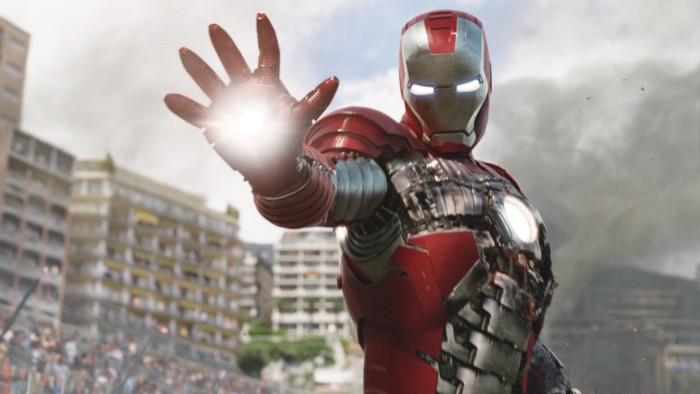The latest wearable fashion: exoskeletons

Roula Khalaf, Editor of the FT, selects her favourite stories in this weekly newsletter.
Wearable robotic suits that can give people superhuman powers have become a regular feature of blockbuster fantasy films.
Exoskeletons, as they are known, played an early role in the Dean Martin 1967 spy oddity The Ambushers, while Sigourney Weaver donned one in Aliens in 1986. A criminal penguin put one to nefarious use in the 1993 Wallace and Grommit animation The Wrong Trousers, and they appeared more forgettably in the 1997 box office bomb Star Kid.
However, since 2009, there has been a veritable explosion of sci-fi adventures featuring powerful, mechanical outerwear: from Tony Stark in the Iron Man and Marvel Avengers series, to James Cameron’s Oscar-winning Avatar, the X-Men films, and current children’s television success Max Steel, exoskeletons have multiplied.
“Now it seems like every science fiction movie has to have an exoskeleton in it,” says Nathan Harding, co-founder and chief executive of California-based Ekso Bionics.
And if Mr Harding — whose company makes exoskeletons — has his way, this highly adaptable, utilitarian form of couture will soon become as fashionable outside the realms of cinema and TV fantasy: in hospitals, army training camps, shipyards and construction sites, for example.
Ekso Bionics already supplies wearable robots that are used in health rehabilitation centres, helping people who have suffered strokes or spinal cord injuries to relearn to walk. There are about 115 motorised units, which cost about $100,000 each, in use in clinics around the world.
The company has a wonderful story related to this rehab application, for the technology dates back to the day 11 years ago when co-founder Russ Angold’s Navy Seal brother broke his neck in an accident.
Mr Angold had always imagined he would make his brother a cool exo-suit to help him in combat, but when his sibling was unable to use his arms, Mr Angold received an education in spinal injuries and the therapeutic uses for exo-suits became clear to him.
Now Mr Angold believes an even bigger market is about to open up in the construction and manufacturing sector. Mr Harding says Ekso is working with several global construction firms on developing suits that would help their workers carry heavier loads, or handle power tools more adeptly.
“It is partly to do with an ageing workforce,” says Mr Harding. “The people with skilled trades are getting older and companies are finding it hard to replace them. This could be a way of keeping people in their jobs for longer. There is a definite demand signal from construction customers.”
Why not just replace workers with robots? Robots are great for doing predictable jobs on a factory production line, says Mr Harding, whereas a human in an exoskeleton is best for a changing, unstructured job scenario, such as a construction site, shipyard or oil refinery. “Robotics is about making machines more mobile and applying more logic to them,” he says. “With exoskeletons, it is attacking the problem from the other end. Humans are already mobile and good with logic.”
Ekso is by no means the only company in this field. A South Korean shipyard has tested exoskeletons for its workers and the Japanese government has been investigating the use of exoskeletons in the clear-up of any future nuclear accidents.
A Swiss start-up called Noonee is developing a simple exoskeleton, worn on the legs, that acts as a “chairless chair”, taking the strain off people who have to stand for long periods.
The widespread adoption of exoskeletons by industry would certainly raise some interesting questions about the nature of work.
Retirement ages, even in very physical trades, would probably rise. And, though receding retirement prospects may dismay workers, there could be a positive outcome in terms of equal opportunities. There would be less ageism and disabled people might find a wider range of jobs open to them.
Even I, a 5ft 2in woman, might contemplate a career in construction if things do not work out for me at the FT.
They might also lead to fewer workplace injuries. For example, could back problems, which currently account for over a quarter of the time off work because of illness, become a thing of the past?
However, the use of exoskeletons could open up new areas of legal dispute — from injuries because of an incorrectly fitted exoskeleton, perhaps.
Despite the onscreen devastation wrought by superheroes, no one on film has yet sued Iron Man. Nonetheless, perhaps it may come as no surprise that at least one US law firm, Littler, has already set up a robotics, artificial intelligence and automation practice.
Comments